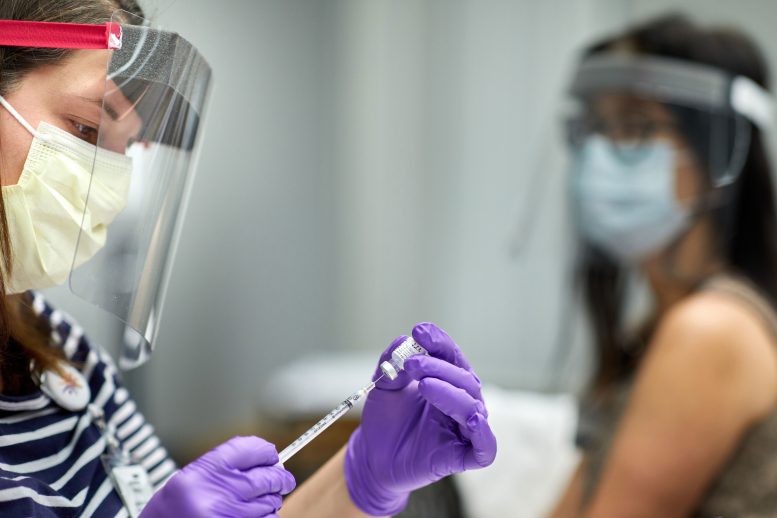The response to an updated vaccine is influenced by previous vaccinations but also produces broadly neutralizing antibodies.
The COVID-19 pandemic has ended, yet the virus responsible continues to circulate, hospitalizing thousands weekly and frequently producing new variants. Due to the virus’s remarkable capacity for mutation and immune evasion, the World Health Organization (WHO) advises yearly updates to COVID-19 vaccines.
However, some scientists worry that the remarkable success of the first COVID-19 vaccines may work against updated versions, undermining the utility of an annual vaccination program. A similar problem plagues the annual flu vaccine campaign; immunity elicited by one year’s flu shots can interfere with immune responses in subsequent years, reducing the vaccines’ effectiveness.
A new study by researchers at Washington University School of Medicine in St. Louis helps to address this question. Unlike immunity to influenza virus, prior immunity to SARS-CoV-2, the virus that causes COVID-19, doesn’t inhibit later vaccine responses. Rather, it promotes the development of broadly inhibitory antibodies, the researchers report.
Benefits of Repeated Vaccination
The study, available online in Nature, shows that people who were repeatedly vaccinated for COVID-19 — initially receiving shots aimed at the original variant, followed by boosters and updated vaccines targeting variants — generated antibodies capable of neutralizing a wide range of SARS-CoV-2 variants and even some distantly related coronaviruses. The findings suggest that periodic re-vaccination for COVID-19, far from hindering the body’s ability to recognize and respond to new variants, may instead cause people to gradually build up a stock of broadly neutralizing antibodies that protect them from emerging SARS-CoV-2 variants and some other coronavirus species as well, even ones that have not yet emerged to infect humans.
“The first vaccine an individual receives induces a strong primary immune response that shapes responses to subsequent infection and vaccination, an effect known as imprinting,” said senior author Michael S. Diamond, MD, PhD, the Herbert S. Gasser Professor of Medicine. “In principle, imprinting can be positive, negative, or neutral. In this case, we see strong imprinting that is positive, because it’s coupled to the development of cross-reactive neutralizing antibodies with remarkable breadth of activity.”
Healthcare workers received the first doses of the COVID-19 vaccine in December 2020. A study by researchers at Washington University School of Medicine in St. Louis has found that repeat vaccination with updated versions of the COVID-19 vaccine promotes the development of antibodies that neutralize a wide range of variants of the virus that causes COVID-19, as well as related coronaviruses. Credit: Matt Miller/Washington University
Imprinting is the natural result of how immunological memory works. A first vaccination triggers the development of memory immune cells. When people receive a second vaccination quite similar to the first, it reactivates memory cells elicited by the first vaccine. These memory cells dominate and shape the immune response to the subsequent vaccine.
In the case of the flu vaccine, imprinting has negative effects. Antibody-producing memory cells crowd out new antibody-producing cells, and people develop relatively few neutralizing antibodies against the strains in the newer vaccine. But in other cases, imprinting can be positive, by promoting the development of cross-reactive antibodies that neutralize strains in both the initial and subsequent vaccines.
Study on Imprinting and Its Effects
To understand how imprinting influences the immune response to repeat COVID-19 vaccination, Diamond and colleagues including first author Chieh-Yu Liang, a graduate student, studied the antibodies from mice or people who had received a sequence of COVID-19 vaccines and boosters targeting first the original and then omicron variants. Some of the human participants also had been naturally infected with the virus that causes COVID-19.
The first question was the strength of the imprinting effect. The researchers measured how many of the participants’ neutralizing antibodies were specific for the original variant, the omicron variant, or both. They found that very few people had developed any antibodies unique to omicron, a pattern indicative of strong imprinting by the initial vaccination. But they also found few antibodies unique to the original variant. The vast majority of neutralizing antibodies cross-reacted with both.
The next question was how far the cross-reactive effect extended. Cross-reactive antibodies, by definition, recognize a feature shared by two or more variants. Some features are shared only by similar variants, others by all SARS-CoV-2 variants or even all coronaviruses. To assess the breadth of the neutralizing antibodies, the researchers tested them against a panel of coronaviruses, including SARS-CoV-2 viruses from two omicron lineages; a coronavirus from pangolins; the SARS-1 virus that caused the 2002-03 SARS epidemic; and the Middle Eastern Respiratory Syndrome (MERS) virus. The antibodies neutralized all the viruses except MERS virus, which comes from a different branch of the coronavirus family tree than the others.
Further experiments revealed that this remarkable breadth was due to the combination of original and variant vaccines. People who received only the vaccines targeting the original SARS-CoV-2 variant developed some cross-reactive antibodies that neutralized the pangolin coronavirus and SARS-1 virus, but the levels were low. After boosting with an omicron vaccine, though, the cross-reactive neutralizing antibodies against the two coronavirus species increased.
Taken together, the findings suggest that regular re-vaccination with updated COVID-19 vaccines against variants might give people the tools to fight off not only the SARS-CoV-2 variants represented in the vaccines, but also other SARS-CoV-2 variants and related coronaviruses, possibly including ones that have not yet emerged.
“At the start of the COVID-19 pandemic, the world population was immunologically naïve, which is part of the reason the virus was able to spread so fast and do so much damage,” said Diamond, also a professor of molecular microbiology and of pathology & immunology. “We do not know for certain whether getting an updated COVID-19 vaccine every year would protect people against emerging coronaviruses, but it’s plausible. These data suggest that if these cross-reactive antibodies do not rapidly wane — we would need to follow their levels over time to know for certain — they may confer some or even substantial protection against a pandemic caused by a related coronavirus.”
Reference: “Imprinting of serum neutralizing antibodies by Wuhan-1 mRNA vaccines” by Chieh-Yu Liang, Saravanan Raju, Zhuoming Liu, Yuhao Li, Guha Asthagiri Arunkumar, James Brett Case, Suzanne M. Scheaffer, Seth J. Zost, Cory M. Acreman, Matthew Gagne, Shayne F. Andrew, Deborah Carolina Carvalho dos Anjos, Kathryn E. Foulds, Jason S. McLellan, James E. Crowe Jr., Daniel C. Douek, Sean P. J. Whelan, Sayda M. Elbashir, Darin K. Edwards and Michael S. Diamond, 15 May 2024, Nature.
DOI: 10.1038/s41586-024-07539-1
The study was funded by the National Institutes of Health, the Vaccine Research Center, and Moderna.
News
AI matches doctors in mapping lung tumors for radiation therapy
In radiation therapy, precision can save lives. Oncologists must carefully map the size and location of a tumor before delivering high-dose radiation to destroy cancer cells while sparing healthy tissue. But this process, called [...]
Scientists Finally “See” Key Protein That Controls Inflammation
Researchers used advanced microscopy to uncover important protein structures. For the first time, two important protein structures in the human body are being visualized, thanks in part to cutting-edge technology at the University of [...]
AI tool detects 9 types of dementia from a single brain scan
Mayo Clinic researchers have developed a new artificial intelligence (AI) tool that helps clinicians identify brain activity patterns linked to nine types of dementia, including Alzheimer's disease, using a single, widely available scan—a transformative [...]
Is plastic packaging putting more than just food on your plate?
New research reveals that common food packaging and utensils can shed microscopic plastics into our food, prompting urgent calls for stricter testing and updated regulations to protect public health. Beyond microplastics: The analysis intentionally [...]
Aging Spreads Through the Bloodstream
Summary: New research reveals that aging isn’t just a local cellular process—it can spread throughout the body via the bloodstream. A redox-sensitive protein called ReHMGB1, secreted by senescent cells, was found to trigger aging features [...]
AI and nanomedicine find rare biomarkers for prostrate cancer and atherosclerosis
Imagine a stadium packed with 75,000 fans, all wearing green and white jerseys—except one person in a solid green shirt. Finding that person would be tough. That's how hard it is for scientists to [...]
Are Pesticides Breeding the Next Pandemic? Experts Warn of Fungal Superbugs
Fungicides used in agriculture have been linked to an increase in resistance to antifungal drugs in both humans and animals. Fungal infections are on the rise, and two UC Davis infectious disease experts, Dr. George Thompson [...]
Scientists Crack the 500-Million-Year-Old Code That Controls Your Immune System
A collaborative team from Penn Medicine and Penn Engineering has uncovered the mathematical principles behind a 500-million-year-old protein network that determines whether foreign materials are recognized as friend or foe. How does your body [...]
Team discovers how tiny parts of cells stay organized, new insights for blocking cancer growth
A team of international researchers led by scientists at City of Hope provides the most thorough account yet of an elusive target for cancer treatment. Published in Science Advances, the study suggests a complex signaling [...]
Nanomaterials in Ophthalmology: A Review
Eye diseases are becoming more common. In 2020, over 250 million people had mild vision problems, and 295 million experienced moderate to severe ocular conditions. In response, researchers are turning to nanotechnology and nanomaterials—tools that are transforming [...]
Natural Plant Extract Removes up to 90% of Microplastics From Water
Researchers found that natural polymers derived from okra and fenugreek are highly effective at removing microplastics from water. The same sticky substances that make okra slimy and give fenugreek its gel-like texture could help [...]
Instant coffee may damage your eyes, genetic study finds
A new genetic study shows that just one extra cup of instant coffee a day could significantly increase your risk of developing dry AMD, shedding fresh light on how our daily beverage choices may [...]
Nanoneedle patch offers painless alternative to traditional cancer biopsies
A patch containing tens of millions of microscopic nanoneedles could soon replace traditional biopsies, scientists have found. The patch offers a painless and less invasive alternative for millions of patients worldwide who undergo biopsies [...]
Small antibodies provide broad protection against SARS coronaviruses
Scientists have discovered a unique class of small antibodies that are strongly protective against a wide range of SARS coronaviruses, including SARS-CoV-1 and numerous early and recent SARS-CoV-2 variants. The unique antibodies target an [...]
Controlling This One Molecule Could Halt Alzheimer’s in Its Tracks
New research identifies the immune molecule STING as a driver of brain damage in Alzheimer’s. A new approach to Alzheimer’s disease has led to an exciting discovery that could help stop the devastating cognitive decline [...]
Cyborg tadpoles are helping us learn how brain development starts
How does our brain, which is capable of generating complex thoughts, actions and even self-reflection, grow out of essentially nothing? An experiment in tadpoles, in which an electronic implant was incorporated into a precursor [...]






















